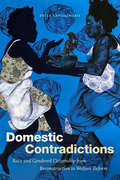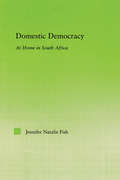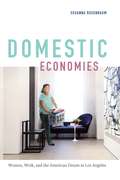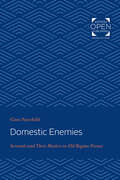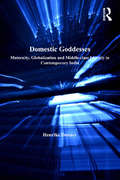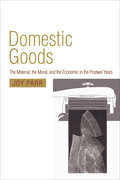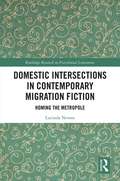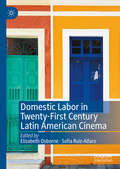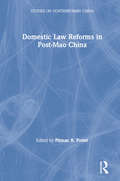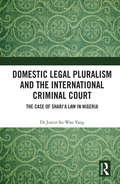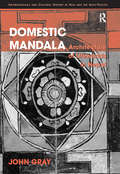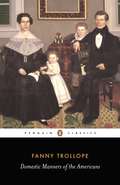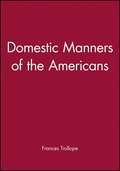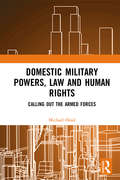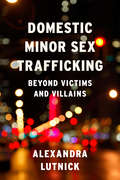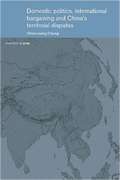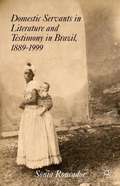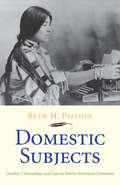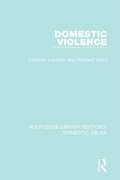- Table View
- List View
Domestic Contradictions: Race and Gendered Citizenship from Reconstruction to Welfare Reform
by Priya KandaswamyIn Domestic Contradictions, Priya Kandaswamy analyzes how race, class, gender, and sexuality shaped welfare practices in the United States alongside the conflicting demands that this system imposed upon Black women. She turns to an often-neglected moment in welfare history, the advent of the Freedmen's Bureau during Reconstruction, and highlights important parallels with welfare reform in the late twentieth century. Kandaswamy demonstrates continuity between the figures of the “vagrant” and “welfare queen” in these time periods, both of which targeted Black women. These constructs upheld gendered constructions of domesticity while defining Black women's citizenship in terms of an obligation to work rather than a right to public resources. Pushing back against this history, Kandaswamy illustrates how the Black female body came to represent a series of interconnected dangers—to white citizenship, heteropatriarchy, and capitalist ideals of productivity —and how a desire to curb these threats drove state policy. In challenging dominant feminist historiographies, Kandaswamy builds on Black feminist and queer of color critiques to situate the gendered afterlife of slavery as central to the historical development of the welfare state.
Domestic Democracy: At Home in South Africa (New Approaches in Sociology)
by Jennifer FishFirst published in 2006. Routledge is an imprint of Taylor & Francis, an informa company.
Domestic Disturbances, Patriarchal Values: Violence, Family and Sexuality in Early Modern Europe, 1600-1900
by Marianna MuravyevaThis book offers an in-depth analysis of several national case studies on family violence between the sixteenth and nineteenth centuries, using court records as their main source. It raises important questions for research on early modern Europe: the notion of absolute power; sovereignty and its applicability to familial power; the problem of violence and the possibility of its usage for conflict resolution both in public and private spaces; and the interconnection of gender and violence against women, reconsidered in the context of modern state formation as a public sphere and family building as a private sphere. Contributors bring together detailed studies of domestic violence and spousal murder in Romania, England, and Russia, abduction and forced marriage in Poland, infanticide and violence against parents in Finland, and rape and violence against women in Germany. These case studies serve as the basis for a comparative analysis of forms, models, and patterns of violence within the family in the context of debates on political power, absolutism, and violence. They highlight changes towards unlimited violence by family patriarchs in European countries, in the context of the changing relationship between the state and its citizens. This book was originally published as a special issue of the Journal of the History of the Family.
Domestic Economic Abuse: The Violence of Money (Routledge Advances in Sociology)
by Supriya SinghSupriya Singh tells the stories of 12 Anglo-Celtic and Indian women in Australia who survived economic abuse. She describes the lived experience of coercive control underlying economic abuse across cultures. Each story shows how the woman was trapped and lost her freedom because her husband denied her money, appropriated her assets and sabotaged her ability to be in paid work. These stories are about silence, shame and embarrassment that this could happen despite professional and graduate education. Some of the women were the main earners in their household. Women spoke of being afraid, of trying to leave, of losing their sense of self. Many suffered physical and mental ill-health, not knowing what would trigger the violence. Some attempted suicide. None of the women fully realised they were suffering family violence through economic abuse, whilst it was happening to them. The stories of Anglo-Celtic and Indian women show economic abuse is not associated with a specific system of money management and control. It is when the morality of money is betrayed that control becomes coercive. Money as a medium of care then becomes a medium of abuse. The women’s stories demonstrate the importance of talking about money and relationships with future partners, across life stages and with their sons and daughters. The women saw this as an essential step for preventing and lessening economic abuse. A vital read for scholars of domestic abuse and family violence that will also be valuable for sociologists of money.
Domestic Economies: Women, Work, and the American Dream in Los Angeles
by Susanna RosenbaumIn Domestic Economies, Susanna Rosenbaum examines how two groups of women—Mexican and Central American domestic workers and the predominantly white, middle-class women who employ them—seek to achieve the "American Dream." By juxtaposing their understandings and experiences, she illustrates how immigrant and native-born women strive to reach that ideal, how each group is indispensable to the other's quest, and what a vital role reproductive labor plays in this pursuit. Through in-depth ethnographic research with these women at work, at home, and in the urban spaces of Los Angeles, Rosenbaum positions domestic service as an intimate relationship that reveals two versions of female personhood. Throughout, Rosenbaum underscores the extent to which the ideology of the American Dream is racialized and gendered, exposing how the struggle for personal worth and social recognition is shaped at the intersection of motherhood and paid employment.
Domestic Enemies: Servants and Their Masters in Old Regime France
by Cissie FairchildsOriginally published in 1983. This book cuts across the class boundaries of traditionally separate fields of social history. It investigates the social origins of servants, their incomes, their marriage and family patterns, their career patterns, their possibilities for social mobility, their political activities, and their criminality. But it also investigates the history of the family and domestic life in France in the sixteenth, seventeenth, and eighteenth centuries, for servants were, at least until the rise of the affectionate nuclear family in the middle of the eighteenth century, considered part of the families of those they served. Finally, this book is also an essay on the history of social relationships in the ancien régime, not only those between masters and servants but also the broader relationships between the ruling elite and the lower classes. The introduction gives basic facts about the composition of households during the Old Regime and explores the attitudes and assumptions that underlay the employment of servants. It also shows how both these attitudes and the households themselves changed dramatically in the last decades before the French Revolution. Part 1 is devoted to the servants themselves. One chapter deals with their lives within their employers' households: their work, their living conditions, their socializing and leisure-time activities. A second examines their private lives: their social origins, marriage and family patterns, their moneymaking and their criminality. And a third explores their relationships with and attitudes toward their masters. In part 2, the focus shifts to an examination of master–servant relationships from the masters' point of view. The first chapter deals with master–servant relationships in general by discussing the factors that determined how employers treated their domestics. The second and third chapters explore two special relationships: masters' sexual relationships with their servants and their relationships with the servants who cared for them in childhood. The epilogue traces the impact of the French Revolution on domestic service and sketches some of the changes in the household that were to come in the nineteenth century.
Domestic Goddesses: Maternity, Globalization and Middle-class Identity in Contemporary India (Urban Anthropology)
by Henrike DonnerBased on extensive fieldwork in Calcutta, this book provides the first ethnography of how middle-class women in India understand and experience economic change through transformations of family life. It explores their ideas, practices and experiences of marriage, childbirth, reproductive change and their children's education, and addresses the impact that globalization is having on the new middle classes in Asia more generally from a domestic perspective. By focusing on maternity, the book explores subjective understandings of the way intimate relationships and the family are affected by India's liberalization policies and the neo-liberal ideologies that accompany through an analysis of often competing ideologies and multiple practices. And by drawing attention to women's agency as wives, mothers and grandmothers within these new frameworks, Domestic Goddesses discusses the experiences of different age groups affected by these changes. Through a careful analysis of women's narratives, the domestic sphere is shown to represent the key site for the remaking of Indian middle-class citizens in a global world.
Domestic Goods
by Joy ParrVisions of life in the 1950s often spring from the United States: supermarkets, freeways, huge gleaming cars, bright new appliances, automated households. Historian Joy Parr looks beyond the generalizations about the indulgence of this era to find a specifically Canadian consumer culture. Focusing on the records left by consumer groups and manufacturers, and relying on interviews and letters from many Canadian women who had set up household in the decade after the war, she reveals exactly how and why Canadian homemakers distinguished themselves from the consumer frenzy of their southern neighbours. Domestic Goods focuses primarily on the design, production, promotion, and consumption of furniture and appliances. For Parr, such a focus demands an analysis of the intertwining of the political, economic, and aesthetic. Parr examines how the shortage of appliances in the early postwar years was a direct result of government reconstruction policy, and how the international style of 'high modernism' reflected the postwar dream of free trade. But while manufacturers devised new plans for the consumer, depression-era frugality and a conscious setting of priorities within the family led potential customers to evade and rework what was offered them, eventually influencing the kinds of goods created. This book addresses questions such as, who designed furniture and appliances, and how were these designs arrived at? What was the role of consumer groups in influencing manufacturers and government policy? Why did women prefer their old wringer washers for over a decade after the automatic washer was brought in? In finding the answers the author celebrates and ultimately suggests reclaiming a particularly Canadian way of consuming.
Domestic Gun Control and International Small Arms Control in Africa
by Niklas HultinThis book, based on field research in the West African country of The Gambia, explores how domestic gun control is shaped by international efforts and how local actors interact with international organizations or opt not to do so. The book also shows how the question of who can have what kind of gun under what circumstances is an intrinsic question to modern societies across the world, but it is seldom one that is addressed in sub-Saharan Africa except in cases of post-conflict countries. Small arms control and gun control are often treated as separate efforts, with the former the domain of international actors such as the United Nations and the latter being of concern to the domestic politics of countries such as the United States. By focusing on a country that has never seen the outbreak of a civil war, the book is able to disentangle the complex roots of gun control in Africa, its origins in colonial era legislation, its reverberations across social life, and how it shapes contemporary understandings of groups ranging for security guards to hunters.
Domestic Homicides and Death Reviews
by Myrna DawsonThis edited collection highlights international research on domestic homicides and death reviews which are a rapidly growing intervention/prevention initiative in various countries. Chapters focus on: the impetus for the international development of such initiatives, the identification of risk factors and recommendations for improving systemic responses, the uptake and impact of these recommendations and, finally, the social and public policy implications of outcomes for developed and developing countries. Despite rapid growth, the current state of research and knowledge about domestic violence death review initiatives is limited, fragmented, and primarily descriptive, largely comprising annual public reports. The authors of this book bridge this significant gap by analysing the wide range of models currently in development and operation. A bold and important examination, this work will have a powerful impact on policy makers and scholars of social science theory, women's studies, and domestic violence.
Domestic Intersections in Contemporary Migration Fiction: At Home in the Metropole
by Lucinda NewnsHoming the Metropole presents a new approach to diasporic fiction that reorients postcolonial readings of migration away from processes of displacement and rupture towards those of placement and homemaking. While notions of home have frequently been associated with essentialist understandings of nation and race, an uncritical investment in tropes of homelessness can prove equally hegemonic. By synthesising postcolonial and intersectional feminist theory, this work establishes the migrant domestic space as a central location of resistance, countering notions of the private sphere as static, uncreative and apolitical. Through close readings of fiction emerging from the African, Caribbean and South Asian diasporas, it reassesses our conception of home in light of contemporary realities of globalisation and forced migration, providing a valuable critique of the celebration of unfixed subject positions that has been a central tenet of postcolonial studies.
Domestic Labor in Twenty-First Century Latin American Cinema
by Elizabeth Osborne Sofía Ruiz-AlfaroThis volume explores the character of the domestic worker in twenty-first century Latin American cinema and analyzes how recent filmic representations of the housemaid question the marginalization of domestic servants, in particular women, by making them the center of their narratives, their families, and society. The essays in this book posit the female domestic worker as an emergent subjectivity, a complex character who problematizes and contests the hierarchical power structures within the family dynamics and new socioeconomic orders found in contemporary Latin America. Readers will find a variety of representations across the continent as well as transnational commonalities of the cinematic figure and role of the housemaid, including the negotiation of a multilayered politics of affection in the framework of prevalent paternalism, and the complex and contradictory dynamic between private and public spaces, where domestic paid labor occupies a central role in maintaining gender, class, and ethnic inequalities.
Domestic Law Reforms in Post-Mao China
by Pitman B. Potter Stanley LubmanThis volume explores various aspects of the law in transition in post-Mao China. Stanley Lubman's introduction places each of the substantive chapters in the larger context of Chinese legal studies. Edward Epstein analyses the transplanting of European and Anglo-American legal ideologies into China, and the dilemmas this poses for the rule of law and legitimation in the reform period. Murray Scot Tanner analyses reforms in the legislative process, focusing particularly on the separation of the Communist Party from day-to-day legislative affairs and more pluralistic tendencies in the legislative process. William C. Jones, by addressing the opinion of the Surpreme People's Court regarding implementation of the general principles of civil law, raises compelling questions about legal interpretation in China in the context of social reform. James Feinerman analyses developments in Chinese contract law, raising the question as to whether in China it can form a basis for predictability and certainty in commercial transactions that are integral to the economic reforms. Judy Polumbaum studies developing efforts to enact a press law, reflecting the uses to which law has been put in pursuit of the political issue of press reform. Finally, Pitman Potter analyses the emerging concept of judicial review in the context of the Administrative Litigation Law of the PRC, an important aspect of political reform in China. By addressing these issues, the authors aim to reveal the various aspects of the developing autonomy that is embodied in China's legal reforms.
Domestic Legal Pluralism and the International Criminal Court: The Case of Shari'a Law in Nigeria
by Justin Su-Wan YangThis book explores how the unique historical development of Islamic Shari’a criminal law alongside English common law in northern Nigeria has created a hybridised criminal legal system through a pluralist dynamic of mutual accommodation. It studies how this system may potentially be accommodated by the International Criminal Court. The work examines how this could be accommodated through the current understanding and operation of complementarity, and that it could ultimately prove to be preferable in encouraging the Shari’a courts to exercise criminal justice over the radical insurgents in northern Nigeria. These courts would have the unprecedented ability to combine binding adjudicative judgments together with religious interpretation and guidance, which can directly combat the predominantly unchallenged domain of ideology by extremist actors. It is submitted that these pluralist perspectives are timely and welcome, given the undeniably Western European foundations of modern International Criminal Law. In exploring such potential avenues, our shared understanding of modern international criminal justice is widened to necessarily include other stakeholders beyond its Western founders. It is the aim and hope that such interactions and engagements with non-Western traditions and cultures will lead to a greater shared ownership of the international criminal justice project, which will only strengthen the global fight against impunity. The book will be essential reading for academics, researchers and policy-makers working in the areas of International Criminal Law, Legal Pluralism, Islamic Shari’a Law, Nigeria, and religiously-inspired violence.
Domestic Mandala: Architecture of Lifeworlds in Nepal (Anthropology and Cultural History in Asia and the Indo-Pacific)
by John GrayA rich and fascinating ethnography of domestic architecture and activities among the high caste Chhetris of Kholagaun in Nepal, this book focuses on the spatial organization, everyday activities and ritual performances that generate and display Chhetri houses as 'mandalas', sacred diagrams that are both maps of the cosmos and machines for revelation. Describing the orientation and layout of the Chhetri house and surrounding compound; it shows how the orientation and distribution of everyday social activities with the domestic mandala shape people's experience of the enigmas of their lifeworld as householders; and analyses the double significance of rituals that take place in the domestic mandala. By treating the Nepali house as more than just the background of people's everyday life, the author reveals the Chhetri everyday lifeworld as a revelation of Hindu tantric cosmology, its enigmatic illusion, and the path to liberation from it. The themes addressed in the book make a unique contribution to the fields of anthropology, architecture and human geography.
Domestic Manners of the Americans
by Fanny TrollopeWhen Fanny Trollope set sail for America in 1827 with hopes of joining a Utopian community of emancipated slaves, she took with her three of her children and a young French artist, leaving behind her son Anthony, growing debts and a husband going slowly mad from mercury poisoning. But what followed was a tragicomedy of illness, scandal and failed business ventures. Nevertheless, on her return to England Fanny turned her misfortunes into a remarkable book. A masterpiece of nineteenth-century travel-writing, Domestic Manners of the Americans is a vivid and hugely witty satirical account of a nation and was a sensation on both sides of the Atlantic. Edited and with notes and introduction by Pamela Melville-Singleton.
Domestic Manners of the Americans
by John Lauritz Larson Frances TrollopeRichly informative on American manners and morals in the early ninteenth century, this famous travel account also reveals much about the contrast between British and American culture.
Domestic Military Powers, Law and Human Rights: Calling Out the Armed Forces
by Michael HeadThis book examines the national and international law, human rights and civil liberties issues involved in governments calling out the armed forces to deal with civil unrest or terrorism. The introduction of domestic military powers has become an international trend. Troops already have been seen on the streets in major Western democracies. These developments raise major political, constitutional and related problems. Examining the changes underway in eight comparable countries—the United States, Canada, Britain, France, Italy, Germany, Japan and Australia—this book provides a review and analysis of this trend, including its implications for legal and political rights. The book will be of interest to the general public, as well as students, academics and policy-makers in the areas of human rights and civil liberties, constitutional law, criminal justice and security studies.
Domestic Minor Sex Trafficking
by Alexandra LutnickThe domestic sex trafficking of minors is a problem of growing concern yet little critical attention. This book analyzes the forces the industry in the United States and provides a much-needed reference for practitioners. It adopts a holistic approach to the issue, pursuing a nuanced exploration of these young people's experiences and takes both their treatment and efforts to combat sex traffick that feeding in productive new directions. The book features interviews with service providers and experts, and incorporates recent research, thereby mapping the complex factors associated with young people's involvement in trading sex and the social connections that facilitate their behavior. It considers the experiences of both those who "choose" sex work and those who are forced into it by circumstances or third parties, and it discusses the networks of friends and close acquaintances who introduce newcomers to the trade. In addition, it takes a hard look at how local and federal responses to trafficking increase young people's vulnerability to trading sex. Urging policymakers and practitioners to move beyond the simple framework of "rescuing" victims and "punishing" villains, this book calls for policies and programs that focus on the failure of social and cultural systems and respond better to the young people caught in this web.
Domestic Murder in Nineteenth-Century England: Literary and Cultural Representations
by Bridget WalshWhy did certain domestic murders fire the Victorian imagination? In her analysis of literary and cultural representations of this phenomenon across genres, Bridget Walsh traces how the perception of the domestic murderer changed across the nineteenth century and suggests ways in which the public appetite for such crimes was representative of wider social concerns. She argues that the portrayal of domestic murder did not signal a consensus of opinion regarding the domestic space, but rather reflected significant discontent with the cultural and social codes of behaviour circulating in society, particularly around issues of gender and class. Examining novels, trial transcripts, medico-legal documents, broadsides, criminal and scientific writing, illustration and, notably, Victorian melodrama, Walsh focuses on the relationship between the domestic sphere, so central to Victorian values, and the desecration of that space by the act of murder. Her book encompasses the gendered representation of domestic murder for both men and women as it tackles crucial questions related to Victorian ideas of nationhood, national health, political and social inequality, newspaper coverage of murder, unstable and contested models of masculinity and the ambivalent portrayal of the female domestic murderer at the fin de siècle.
Domestic Politics, International Bargaining and China's Territorial Disputes (Politics In Asia Ser.)
by Chien-peng ChungThis is a groundbreaking analysis of China's territorial disputes, exploring the successes and failures of negotiations that have taken place between its three neighbours, namely India, Japan and Russia. By using Roberts Putnam's two level game framework, Chung relates the outcome of these disputes to the actions of domestic nationalist groups who
Domestic Satellite/h: An Fcc Giant Step
by Robert S. MagnantIn a society where as much as 50 percent of the gross national product is spent on information transfer services, trends in communications policy and capabilities become extremely important and can have major consequences. During the past ten years, the Federal Communications Commission has made a major effort to promote competition and innovation in the telecommunications industry. But, in order that public interests be identified and adequately served, there must be a wider understanding of the industry and the issues. Robert Magnant takes full account of the multidisciplinary nature of the telecommunications field, and in this book presents an objective treatment of technological trends, policy issues, and market constraints. His study has been designed to provide intelligible, easily accessible information for the legislator, the business leader, the concerned citizen. It deals with the specific area of telecommunications, but in its complete coverage of a major domestic policy issue, it is at the same time an excellent case study to illuminate the intricacies and options in the formulation and operation both of general government and business policy and, more specifically, regulated market structures.
Domestic Servants in Literature and Testimony in Brazil, 1889–1999
by Sônia RoncadorDrawing from a variety of historical sources, theory, and fictional and non-fictional production, this book addresses the cultural imaginary of domestic servants in modern Brazil and demonstrates maids' symbolic centrality to shifting notions of servitude, subordination, femininity, and domesticity.
Domestic Subjects
by Beth H. PiatoteAmid the decline of U.S. military campaigns against Native Americans in the late nineteenth century, assimilation policy arose as the new front in the Indian Wars, with its weapons the deployment of culture and law, and its locus the American Indian home and family. In this groundbreaking interdisciplinary work, Piatote tracks the double movement of literature and law in the contest over the aims of settler-national domestication and the defense of tribal-national culture, political rights, and territory.
Domestic Violence (Routledge Library Editions: Domestic Abuse #5)
by Deborah Lockton Richard WardFirst published in 1997, this book marks a culmination of a three year research programme focused upon the incidence of domestic violence in Leicester. The study examined the levels of violence, the details of applicants and respondents and the nature of complaints, as well as the policies applied and the problems faced by those enforcing the law. The books sets the findings in the context of the policies on protection of victims of domestic violence, the problems they face and protection after 1997. This book will be of interest to those studying law, social work, sociology and women’s studies.
